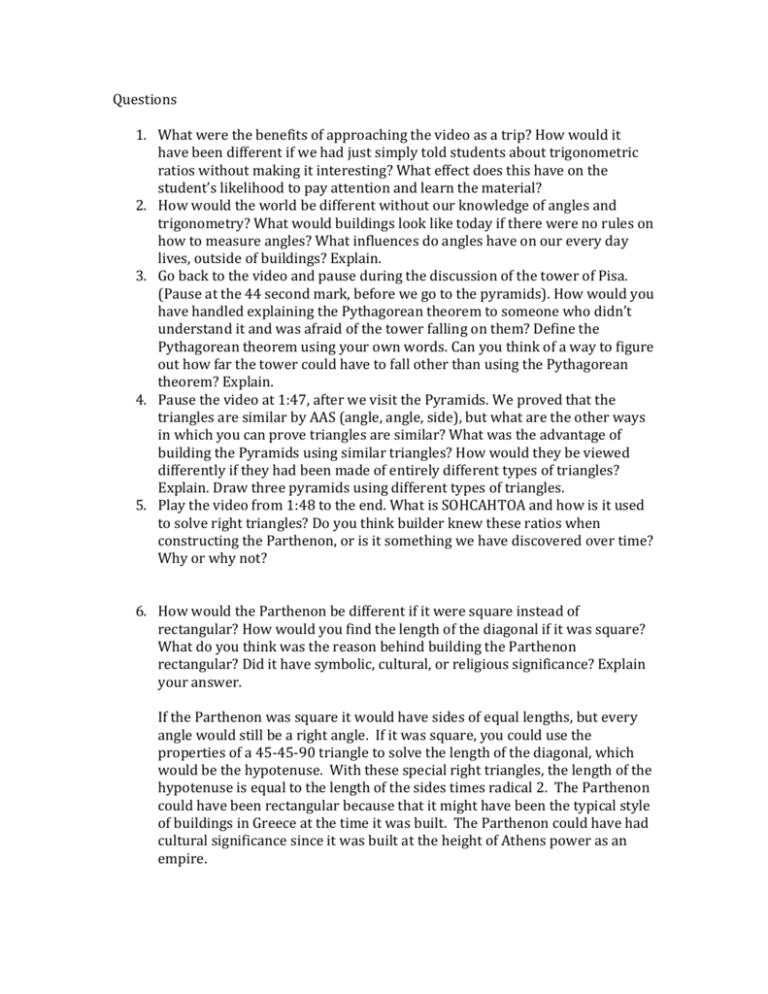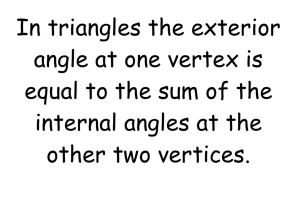File - Angles Today and In Ancient History
advertisement

Questions 1. What were the benefits of approaching the video as a trip? How would it have been different if we had just simply told students about trigonometric ratios without making it interesting? What effect does this have on the student’s likelihood to pay attention and learn the material? 2. How would the world be different without our knowledge of angles and trigonometry? What would buildings look like today if there were no rules on how to measure angles? What influences do angles have on our every day lives, outside of buildings? Explain. 3. Go back to the video and pause during the discussion of the tower of Pisa. (Pause at the 44 second mark, before we go to the pyramids). How would you have handled explaining the Pythagorean theorem to someone who didn’t understand it and was afraid of the tower falling on them? Define the Pythagorean theorem using your own words. Can you think of a way to figure out how far the tower could have to fall other than using the Pythagorean theorem? Explain. 4. Pause the video at 1:47, after we visit the Pyramids. We proved that the triangles are similar by AAS (angle, angle, side), but what are the other ways in which you can prove triangles are similar? What was the advantage of building the Pyramids using similar triangles? How would they be viewed differently if they had been made of entirely different types of triangles? Explain. Draw three pyramids using different types of triangles. 5. Play the video from 1:48 to the end. What is SOHCAHTOA and how is it used to solve right triangles? Do you think builder knew these ratios when constructing the Parthenon, or is it something we have discovered over time? Why or why not? 6. How would the Parthenon be different if it were square instead of rectangular? How would you find the length of the diagonal if it was square? What do you think was the reason behind building the Parthenon rectangular? Did it have symbolic, cultural, or religious significance? Explain your answer. If the Parthenon was square it would have sides of equal lengths, but every angle would still be a right angle. If it was square, you could use the properties of a 45-45-90 triangle to solve the length of the diagonal, which would be the hypotenuse. With these special right triangles, the length of the hypotenuse is equal to the length of the sides times radical 2. The Parthenon could have been rectangular because that it might have been the typical style of buildings in Greece at the time it was built. The Parthenon could have had cultural significance since it was built at the height of Athens power as an empire. 7. If you were conducting this tour of ancient civilizations, what building would you visit? Why? What purpose would this building serve in teaching students about trigonometry and angles? How are angles important in building ancient structures? I would have taken a tour of the Eiffel tower because it is an iconic structure with lots of angles. The building could be used to teach about many principles of geometry because it is made of multiple types of angles and shapes including squares and triangles. Angles are extremely important when building these structures because they keep the building from collapsing on itself and even keep them standing straight. If all the angles in the Eiffel tower weren’t measured correctly, it may not even be standing today. 8. Go to the smartboard file. Go to the fourth slide of the coliseum. How is this different from other buildings we have seen? What is the purpose in making the structure this way? How could you use the protractor to measure the angle at which it was built? Can you? Why or Why not? What does this tell us about how some ancient buildings were built? Explain. The coliseum is different from the other buildings we’ve seen because instead of being triangular or rectangular, it is circular. The building was probably made this way simply because this style was prominent at the time it was built, and the coliseum was used for the spectator sport of gladiator fights, and typically stadiums for spectator sports are circular. It’s impossible to use the protractor to measure the angle at which the coliseum was built because it was not built at angle. The coliseums shape tells us that some buildings were not built using as many angles as others do, and the buildings purpose can influence how the building is constructed. 9. On the smart board file, you are given a protractor to measure angles on the buildings. In ancient times, did builder have tools such as these? If not, what do you think they used? How did they measure angles in a precise way? What would be some problems of not having a protractor or measuring device when building such magnificent structures? Explain. Ancient civilizations did not have protractors like the ones we use today. Instead of using tools to measure angles, I think they used math and geometry principles like sohcahtoa and the Pythagorean theorem to accurately measure angles in a precise way. Some problems that may occur when not having a protractor or other measuring device though could be doing the math wrong, and measuring angles incorrectly could result in a variety of issues, such as the building being unstable. 10. What would be the consequences of measuring an angle wrong when building these structures? What effect would that have on the reputation of the building and the builders themselves? What do you think the reputation of the builders of the tower of Pisa is now that it is beginning to lean? Explain. What would have happened in ancient times if a builder’s building crumbled to the ground? Measuring an angle wrong could result in building instability or even the collapse of the building. I think if a building had poor structure, it would reflect poorly on the builders, and no one would want to hire them to build anything ever again. I think the builders of the tower of Pisa have a bad reputation since they were not intelligent enough to build the tower on stable soil. In ancient times, I think if a builder’s structure crumbled to the ground it would have resulted in the builder being fired or maybe even killed depending on how cruel the person who hired them was.






